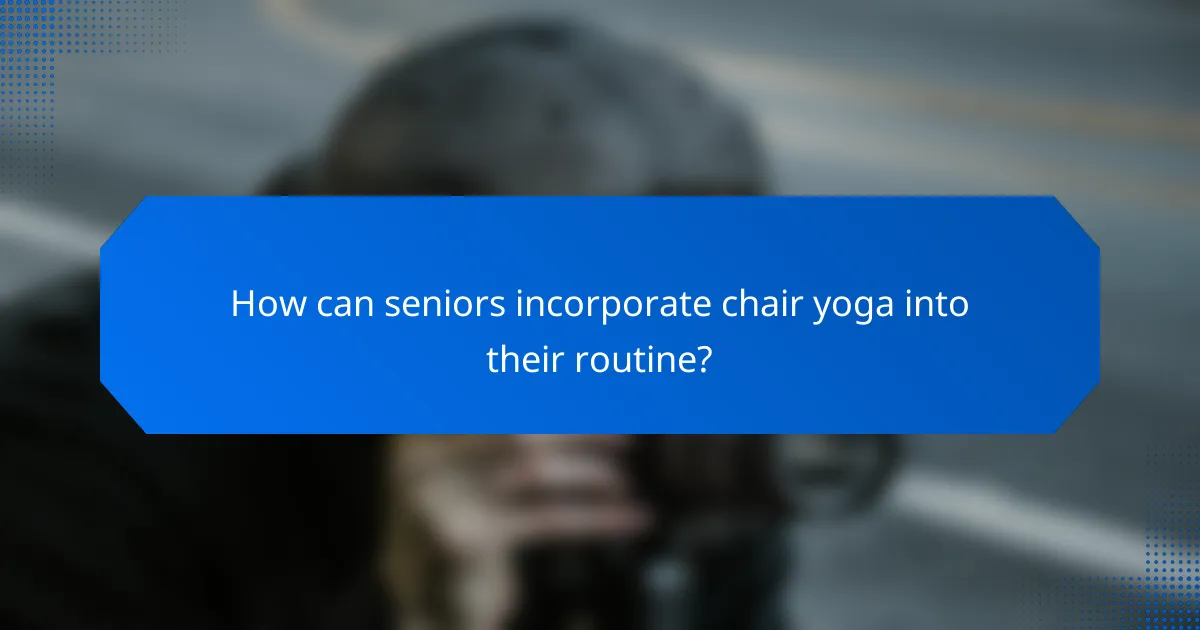Chair yoga is an excellent practice for seniors, especially those with limited mobility, as it promotes physical health and enhances mental well-being. By focusing on gentle movements that can be performed while seated, chair yoga provides an accessible way for individuals to improve flexibility and strength. Incorporating this practice into daily routines can foster a sense of community and support overall wellness.

How does chair yoga benefit seniors in the UK?
Chair yoga offers numerous benefits for seniors in the UK, particularly those with limited mobility. It promotes physical health, enhances mental well-being, and fosters a sense of community among participants.
Improves flexibility
Chair yoga helps seniors increase flexibility by allowing them to perform stretches and movements without the need to get on the floor. Simple poses, such as seated forward bends or side stretches, can be done while seated, making it accessible for those with mobility challenges.
Regular practice can lead to improved range of motion in joints, which is crucial for maintaining independence in daily activities. Seniors should aim to practice chair yoga several times a week to see noticeable improvements.
Enhances balance
Balance is essential for preventing falls, a common concern for seniors. Chair yoga incorporates poses that strengthen core muscles and improve stability, such as seated leg lifts and gentle twists.
By focusing on balance during sessions, seniors can build confidence in their movements. It is advisable to practice in a safe environment, using a sturdy chair for support as needed.
Reduces stress
Chair yoga promotes relaxation and reduces stress through mindful breathing and gentle movements. Techniques such as deep breathing and guided imagery can help calm the mind and lower anxiety levels.
Engaging in chair yoga regularly can lead to improved mood and emotional well-being. Seniors may find it beneficial to incorporate short sessions into their daily routine, even if just for a few minutes.
Promotes social interaction
Participating in chair yoga classes provides seniors with an opportunity to connect with others, fostering social interaction and reducing feelings of isolation. Group settings encourage camaraderie and support among participants.
Many community centers and local organizations in the UK offer chair yoga classes specifically designed for seniors. Joining a class can enhance motivation and create a sense of belonging, which is vital for mental health.

What are effective chair yoga poses for limited mobility?
Effective chair yoga poses for limited mobility focus on gentle movements that enhance flexibility and strength without requiring extensive physical exertion. These poses can be performed while seated, making them accessible for seniors and individuals with limited mobility.
Seated cat-cow stretch
The seated cat-cow stretch is a gentle way to improve spinal flexibility and relieve tension in the back. To perform this stretch, sit up straight in your chair with your feet flat on the floor. Inhale as you arch your back and lift your chest, then exhale as you round your spine and tuck your chin to your chest. Repeat this sequence for several breaths.
Focus on moving slowly and synchronizing your breath with your movements. This stretch can be done for about one to two minutes, providing a calming effect while promoting better posture.
Chair pigeon pose
Chair pigeon pose helps to open the hips and stretch the glutes, which can alleviate discomfort from prolonged sitting. To do this pose, sit tall in your chair and cross one ankle over the opposite knee. Gently press down on the crossed knee while leaning forward slightly to deepen the stretch. Hold this position for 20 to 30 seconds, then switch sides.
Ensure that your back remains straight and avoid any sharp pain. This pose is particularly beneficial for those who experience tightness in the hips, making it a great addition to a chair yoga routine.
Seated forward bend
The seated forward bend is a simple yet effective pose that stretches the back and hamstrings. Begin by sitting at the edge of your chair with your feet hip-width apart. Inhale deeply, then exhale as you lean forward, reaching your hands toward your feet or the floor. Hold this position for 15 to 30 seconds, breathing deeply throughout.
Keep your knees slightly bent if needed to avoid strain. This pose can help reduce stress and improve circulation, making it an excellent choice for seniors looking to enhance their overall well-being.

How can seniors incorporate chair yoga into their routine?
Seniors can easily integrate chair yoga into their daily routine by setting aside a few minutes each day for practice. This form of yoga is designed to be accessible, allowing individuals with limited mobility to engage in gentle stretches and movements that promote health and well-being.
Daily practice recommendations
For effective chair yoga practice, aim for sessions lasting between 10 to 30 minutes each day. Start with simple stretches and breathing exercises, gradually increasing the complexity as comfort grows. Consistency is key; try to practice at the same time each day to build a routine.
Consider incorporating a mix of seated poses, such as seated cat-cow and seated forward bends, to enhance flexibility and strength. Listening to your body is crucial; if a pose feels uncomfortable, modify it or skip it altogether.
Group classes in community centers
Many community centers offer chair yoga classes specifically tailored for seniors. These classes provide a supportive environment where participants can learn from an instructor and connect with others. Group settings can enhance motivation and accountability.
Check local listings for classes that fit your schedule, and consider attending a trial session to see if it suits your needs. Some centers may offer classes at low or no cost, making it an accessible option for many seniors.
Online resources and videos
Numerous online platforms provide free or affordable chair yoga videos designed for seniors. Websites like YouTube feature a variety of instructors and styles, allowing individuals to find sessions that resonate with them. Look for videos that emphasize safety and proper alignment.
When choosing online resources, consider the length and level of difficulty of the sessions. Start with shorter, beginner-friendly videos and gradually progress to longer or more challenging routines as your confidence and ability grow.

What equipment is needed for chair yoga?
Chair yoga requires minimal equipment, making it accessible for seniors and those with limited mobility. The essential items include a sturdy chair, a yoga strap, and a non-slip mat to ensure safety and comfort during practice.
Sturdy chair
A sturdy chair is the foundation of chair yoga. It should have a solid frame, a comfortable seat, and ideally, armrests for added support. Look for chairs that are at a height allowing your feet to rest flat on the floor when seated.
Ensure the chair is stable and does not slide on the floor. Avoid chairs with wheels or those that are too soft, as they can lead to instability during exercises.
Yoga strap
A yoga strap is a versatile tool that helps improve flexibility and reach during chair yoga. It can assist in stretching and holding poses, especially for those with limited mobility. Straps typically come in various lengths, so choose one that suits your height and reach.
When using a yoga strap, loop it around your foot or hand to extend your reach. This can help you maintain proper alignment and deepen stretches without straining your muscles.
Non-slip mat
A non-slip mat provides additional safety during chair yoga sessions. It helps prevent the chair from sliding and offers a stable surface for your feet. Look for mats made from rubber or other non-slip materials that provide good traction.
Place the mat under the chair to ensure it stays in place. This is particularly important for seniors, as it reduces the risk of falls and enhances overall stability during practice.

What should seniors consider before starting chair yoga?
Seniors should consider their physical condition and any existing health issues before starting chair yoga. This practice can be beneficial, but understanding personal limitations and consulting with healthcare providers is essential for safety and effectiveness.
Consultation with healthcare providers
Before beginning chair yoga, seniors should consult with their healthcare providers to discuss any medical conditions or concerns. This step ensures that the exercises are safe and appropriate for their specific health needs.
Healthcare professionals can provide tailored advice, recommend suitable modifications, or suggest specific poses that align with the individual’s health status. For example, those with arthritis may need to avoid certain movements that could exacerbate their condition.
Understanding personal limitations
Recognizing personal limitations is crucial for a safe chair yoga experience. Seniors should assess their mobility, balance, and any pain levels to determine which poses are feasible and comfortable.
A practical approach is to start with basic stretches and gradually incorporate more complex movements as confidence and ability increase. Keeping a journal to track progress and comfort levels can also help in understanding personal boundaries and adjusting routines accordingly.


